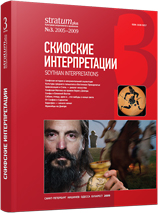Каменные изваяния в контексте этнополитической истории Скифии
Stone Sculptures in the Context of Ethnopolitical History of Scythia
Author(s): Svetlana S. BessonovaSubject(s): History, Archaeology, Ancient World
Published by: Издательский дом Stratum, Университет «Высшая антропологическая школа»
Summary/Abstract: The work views Scythian sculptures on the territory from the Northern Caucasus to Dobruja. The author used the data from the research by V.S. Olkhovskyj (catalogue compiled in cooperation with H.L. Yevdokymov, dating, and typology) with little additions. The sculptures were analyzed within three large areas: Northern Caucasus, coast of the Sea of Azov, north coast of the Black Sea (Ольховский 1999). The attempt is made to analyze the finds in a wide archaeological context including the types of burial monuments, topography, communications, and the degree of vicinity of Scythian and Ancient Greek centres. The main goal of the research is to determine (by the relation to the burial monuments) the ethnical environment of Scythian sculptures and to define, as far as possible, the type and scales of social communities they belonged to. There are good reasons to beleive that the tradition of erecting anthropomorphic sculptures was originally inherent to specific nomad ethnos, with particular ideology, which consequently formed the core of the Scythian military and political union and was known as Royal Scythians. The territorial distribution of sculptures reflects the process of struggle by ethnos-hegemon for the priority economic zones.
Journal: Stratum plus. Археология и культурная антропология
- Issue Year: 2009
- Issue No: 3
- Page Range: 14-93
- Page Count: 80
- Language: Russian
- Content File-PDF

